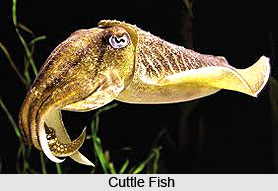 Cuttlefishes are two-gilled cephalopods living between stones and in rock fissures in the sea usually at a depth of a few fathoms. They often come into shallow waters also. They belong to the genus Sepia. The animal has a distinct head, bearing eight stumpy sucker-clad arms, two long arms with suckers at their ends, and a pair of prominent and highly developed eyes, resembling in size and appearance those of a fish. The head is connected with the body by a neck. The trunk or body is shaped like a small elongated shield; the base of the shield is towards the head. The body of the animal is supported internally by a long calcareous piece which is laminated, porous and brittle and is popularly known as cuttlebone. Each side of the body of a cuttle fish bears a fin which is used as a swimming organ. It is by ejecting water through the funnel the animal that is the cuttle fish darts rapidly through the water.
Cuttlefishes are two-gilled cephalopods living between stones and in rock fissures in the sea usually at a depth of a few fathoms. They often come into shallow waters also. They belong to the genus Sepia. The animal has a distinct head, bearing eight stumpy sucker-clad arms, two long arms with suckers at their ends, and a pair of prominent and highly developed eyes, resembling in size and appearance those of a fish. The head is connected with the body by a neck. The trunk or body is shaped like a small elongated shield; the base of the shield is towards the head. The body of the animal is supported internally by a long calcareous piece which is laminated, porous and brittle and is popularly known as cuttlebone. Each side of the body of a cuttle fish bears a fin which is used as a swimming organ. It is by ejecting water through the funnel the animal that is the cuttle fish darts rapidly through the water.
All cuttlefishes have an ink-sac placed near their anal opening. They protect themselves by emitting a dark fluid from the sac and hide from their enemies in this smoke-screen. The name Sepia given to these molluscs refers to the brown pigment called sepia made from the dried and pulverized contents of the ink-sac of cuttlefishes and their allies.
The living cuttlefish exhibits frequent changes. These changes are due to the contraction and relaxation of certain pigment cells contained under the animal. In some cases the cell displays rainbow like colours. In cuttlefishes the sexes are separate. Mating takes place during the breeding season and fertilization is internal. The female cuttle fishes have certain special glands. The eggs of cuttlefishes are curious objects containing yolk. A capsule which is large and black holds many cuttlefish eggs. As the egg increases in size and when the embryo leaves the egg the yolk is gradually absorbed and it looks like a miniature adult. The cuttlefish eggs have no free-swimming stage.
The soft calcareous cuttlebones have economic value. They are gathered in the months of February and March, i.e. during the pre-southwest monsoon months when large numbers of them are cast ashore. These soft bones are used for cleaning glass and for polishing silver.



















